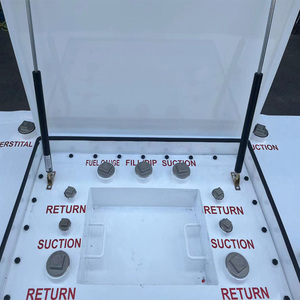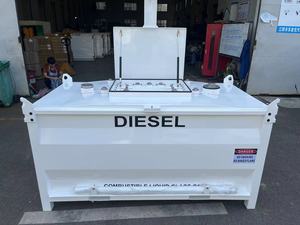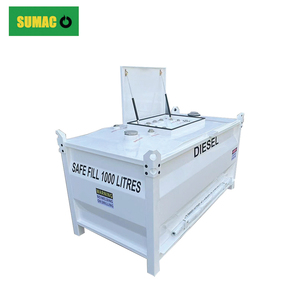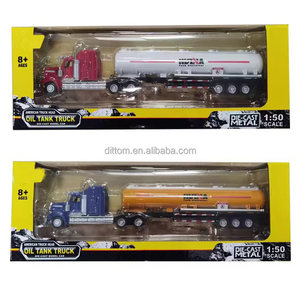Types of Diecast Tanker Trucks
Diecast tanker trucks are precision-crafted miniature replicas of real-world tanker vehicles. These collectible models come in various types that reflect their full-size counterparts' specialized functions in the transportation industry.
Oil Tanker Trucks
Designed to transport petroleum products including gasoline, diesel, and crude oil. These models typically feature realistic safety elements like fire extinguishers and emergency shut-off valve details. The tanks usually have distinctive cylindrical shapes with reinforced sections.
Chemical Tanker Trucks
These models replicate trucks used for chemical transport, including hazardous and non-hazardous substances. Premium diecast versions include special detailing that represents corrosion-resistant coatings and compartmentalized tanks designed to prevent chemical reactions.
Water Tanker Trucks
These replicate vehicles used in construction, firefighting, and agricultural irrigation. Collector-quality water tanker models often feature functional details like miniature water pumps, hose connectors, and spray nozzles that enhance their display value.
Milk Tanker Trucks
Representing refrigerated vehicles that transport milk from dairy farms to processing plants. Premium models feature insulated tank designs, temperature gauge details, and often come with dairy company branding that adds to their collectible appeal.
Fuel Tanker Trucks
These models replicate trucks that deliver various fuel types to gas stations. Collector-grade versions include multi-compartment tank designs with separate loading hatches and detailed safety features that prevent fuel spill and explosion risks.
LNG Tanker Trucks
Specialized models that replicate trucks transporting liquefied natural gas. High-quality diecast versions feature insulated tank designs with distinctive pressure-maintenance systems and cryogenic cooling details that showcase the specialized nature of these vehicles.
Asphalt Tanker Trucks
These models represent heated transport vehicles used in road construction. Premium versions include insulated tank designs with heating element details and specialized discharge mechanisms that reflect the unique requirements of asphalt transportation.
Diecast Tanker Truck Popularity by Type
| Truck Type | Collector Appeal | Typical Price Range | Availability |
|---|---|---|---|
| Oil Tanker | High | $40-120 | Widely Available |
| Fuel Tanker | Very High | $45-150 | Common |
| Chemical Tanker | Medium | $50-130 | Somewhat Limited |
| Milk Tanker | Medium-High | $35-100 | Common |
| Water Tanker | Medium | $30-90 | Common |
| LNG Tanker | High (Specialty) | $55-180 | Limited |
| Asphalt Tanker | Medium | $40-110 | Somewhat Limited |
Collector's Tip: When building a diecast tanker truck collection, consider focusing on a specific category or brand to create a more cohesive and valuable collection. Oil and fuel tankers with authentic company branding tend to hold their value better over time.
Specifications & Maintenance of Diecast Tanker Trucks
Understanding the detailed specifications of diecast tanker trucks is essential for collectors, retailers, and enthusiasts alike. These specifications determine quality, value, and collectibility.
Standard Specifications
- Material: Premium zinc alloy diecast metal providing optimal weight and durability with occasional plastic components for detailed features
- Scale: Available in multiple precision scales including 1:43, 1:50 (industry standard), 1:64, 1:87, and 1:200
- Number of axles: Ranges from 3-5 axles depending on the model and scale, accurately reflecting real-world truck configurations
- Cab design: Options include single or double cab with highly detailed interiors, mirrors, and driver compartments
- Tank shape: Precision-engineered oval, circular, or square tanks depending on the liquid type represented
- Functionality: Collection-grade display models vs. interactive models with movable parts or remote control capabilities
- Detailing: Hand-painted details, miniature warning labels, company logos, and authentic color schemes
- Packaging: Protective display cases or window boxes with authenticity certificates for collector models
Essential Maintenance
- Regular cleaning: Use soft microfiber cloths or specialized model brushes to gently remove dust; avoid abrasive materials that can scratch delicate surfaces
- UV protection: Store models away from direct sunlight to prevent color fading and material degradation over time
- Humidity control: Maintain 40-50% relative humidity to prevent metal corrosion and paint deterioration
- Careful handling: Handle models by the sturdy chassis rather than delicate components to prevent breakage and paint chipping
- Display considerations: Use enclosed display cases with UV-protective glass for valuable collections
- Regular inspection: Periodically check for loose parts, beginning corrosion, or paint issues to address problems early
- Cleaning solutions: Use only pH-neutral cleaning products specifically designed for collectibles
- Storage environment: Maintain consistent temperature between 65-75°F (18-24°C) to prevent metal expansion/contraction
Scale Comparison Chart
| Scale | Typical Size (Length) | Level of Detail | Collector Preference | Best For |
|---|---|---|---|---|
| 1:43 | 9-12 inches | Very High | Serious Collectors | Showcase Displays |
| 1:50 | 8-10 inches | High | Industry Standard | Commercial Displays |
| 1:64 | 5-7 inches | Medium-High | General Collectors | Practical Collections |
| 1:87 | 3-5 inches | Medium | Model Railways | Dioramas/Railways |
| 1:200 | 1-3 inches | Low-Medium | Space-Limited | Large Fleet Displays |
Important Maintenance Warning: Never use household cleaning chemicals on diecast models. Products containing ammonia, acetone, or alcohol can permanently damage paint finishes and dissolve delicate decals. Always test any cleaning solution on an inconspicuous area first.
How to Choose Diecast Tanker Trucks
Selecting the ideal diecast tanker truck model for your collection or retail business requires careful consideration of several key factors. This comprehensive guide will help you make informed decisions.
Type of Liquid Transported
Select models based on the liquid they represent transporting for targeted appeal. Oil and gas tankers appeal to energy industry professionals, while milk tankers attract agricultural enthusiasts. Consider your customer base or personal collection theme when making this choice.
Company Branding
Models featuring authentic logos from recognizable companies like Shell, Exxon, or regional dairy producers significantly increase collectibility and value. For retailers, offering customization services to add client company logos can be a profitable differentiation strategy.
Size and Scale
The scale determines both display requirements and detail level. Larger 1:43 or 1:50 scales offer impressive detail but require more space, while smaller 1:87 or 1:200 scales allow for larger fleet displays in limited areas. Match scale to your available display space or customer preferences.
Features and Details
Premium models offer working features like opening hatches, rotating wheels, steering functionality, and removable parts. The quality of small details like mirrors, lights, warning labels, and ladder rungs often indicates overall model quality and authenticity.
Brand and Quality
Reputable manufacturers like Corgi, Tekno, WSI Models, and First Gear are known for superior craftsmanship. Research manufacturer reputations through collector forums and reviews to ensure you're investing in high-quality models that maintain their value over time.
Price and Affordability
Prices vary significantly based on scale, detail level, limited edition status, and manufacturer reputation. Establish a clear budget range while understanding that higher-quality models typically retain value better. For retailers, stock a range of price points to accommodate different customer segments.
Target Market
Consider whether your models will appeal to serious adult collectors (who prioritize accuracy and detail), casual enthusiasts (who may focus on brand recognition), or younger collectors (who might prefer interactive features). Align your selection with your primary audience's preferences.
Availability and Supply
Ensure your supplier can provide consistent inventory, especially for retail businesses. Limited edition models may offer higher margins but can be difficult to restock. Establish relationships with multiple reliable suppliers to maintain inventory diversity and availability.
Selection Criteria Weight Chart
| Selection Factor | Collector Importance | Retailer Importance | Key Consideration |
|---|---|---|---|
| Brand Quality | Very High | High | Determines long-term value |
| Scale | High | Medium | Must match collection or display space |
| Detail Level | Very High | Medium-High | Directly impacts perceived value |
| Company Branding | Medium-High | High | Increases specific customer appeal |
| Price | Medium | Very High | Must fit budget constraints |
| Limited Edition Status | High | Medium | Affects long-term collectibility |
| Functional Features | Medium | High | Appeals to interactive collectors |
Expert Selection Advice: When building a retail inventory or personal collection, invest in at least a few premium-quality models from top manufacturers. These serve as anchor pieces that elevate the perceived value of your entire collection and demonstrate quality commitment to customers or fellow collectors.
Storage and Care for Diecast Tanker Trucks
Proper storage and handling are essential for maintaining the condition and value of diecast tanker truck collections. Follow these professional guidelines to preserve your models' appearance and functionality.
Check the Storage Area
Select a clean, climate-controlled environment away from direct sunlight, heat sources, and high humidity. Ideal storage locations maintain consistent temperature (65-75°F/18-24°C) and moderate humidity (40-50%). Avoid basements and attics where temperature and humidity fluctuate dramatically.
Inspect for Damage
Regularly examine storage containers for signs of damage, moisture infiltration, or pest activity. Use acid-free tissue paper or soft cloth to separate models and prevent paint transfer or scratching. Document existing condition with photos for valuable pieces to track any deterioration over time.
Sort and Organize
Categorize models by manufacturer, scale, type, or theme to create a systematic collection. Use inventory management software or spreadsheets to track your collection details. Consider display rotation systems to showcase different models while keeping others safely stored.
Clean the Storage Area
Thoroughly clean storage areas with pH-neutral products before placing models. Install dust-free shelving or cabinets specifically designed for collectibles. Use silica gel packets in enclosed storage to absorb excess moisture and prevent corrosion.
Inspect for Missing Parts
Create a detailed parts inventory for complex models with removable components. Store small detachable parts in labeled mini-bags alongside their respective models. Contact manufacturers directly for replacement parts for high-value collectibles when available.
Test Moving Mechanism
Gently test articulated components quarterly without forcing movement. Apply specialized model lubricant sparingly to moving parts showing resistance. Never use household oils which can attract dust and degrade plastic components.
Check Paint and Finish
Use magnifying equipment to inspect for early signs of paint deterioration or metal oxidation. Apply professional-grade model polish or wax designed specifically for diecast items to protect finishes. For valuable collectibles, consider professional restoration rather than DIY repairs.
Replace Missing Parts
Research specialist suppliers like Model Parts Direct, Scale Auto Enthusiast, or manufacturer service departments for authentic replacement components. Consider joining collector communities where members may have spare parts available. For rare or discontinued models, custom 3D-printed replacements may be an option.
Long-Term Storage Options Comparison
| Storage Method | Protection Level | Visibility | Cost | Best For |
|---|---|---|---|---|
| Custom Display Cases | Very High | High | $$$ | Valuable individual pieces |
| Glass Cabinets | High | High | $$$ | Showcase collections |
| Acrylic Boxes | High | High | $$ | Mid-value models |
| Original Packaging | Medium-High | Low | $ | Investment models |
| Acid-Free Boxes | Medium | None | $ | Long-term storage |
| Model Display Shelves | Low | Very High | $$ | Frequently viewed pieces |
Storage Warning: Never store diecast models in plastic bags or non-archival cardboard boxes. These materials can emit gases that damage paint and metal surfaces over time. Always use acid-free tissue, archival-quality containers, or purpose-built display cases for long-term storage.
Frequently Asked Questions
Diecast tanker trucks have gained exceptional popularity among collectors for several compelling reasons. Their intricate detail and craftsmanship make them miniature works of art, with precise scale reproductions of real-world vehicles. The historical significance of these models often represents important transportation and industrial evolution. Many collectors appreciate how these models document the evolution of commercial vehicle design and corporate branding over decades.
Additionally, their durability makes them excellent long-term investments, with limited edition models often appreciating in value. For industry professionals, these models serve as meaningful representations of their careers in transportation, energy, or agriculture, creating emotional connections beyond mere collecting.
Yes, diecast tanker trucks can be customized through several professional and DIY approaches. Many collectors use specialized model paints for recoloring or adding weathering effects to create more realistic appearances. Custom decals and water-slide transfers allow for personalized company branding or unique identity creation.
For more advanced customization, parts swapping between compatible models enables unique configurations, while detail enhancement with aftermarket accessories (like miniature chains, hoses, or mirrors) adds realism. Some collectors even employ professional model customization services for museum-quality modifications. However, collectors should note that extensive modifications to rare or valuable models may reduce their market value among purists who prefer original condition pieces.
While diecast tanker trucks are manufactured in various scales to suit different collector preferences, the 1:50 scale has emerged as the industry standard and most common scale for commercial and collector-grade tanker truck models. This scale offers an optimal balance between detail representation and practical display size.
The 1:50 scale is particularly favored by professional transportation-related businesses for promotional models and office displays. However, other popular scales include 1:64 (convenient for larger collections in limited space), 1:43 (preferred by premium collectors for its enhanced detail), and 1:87 (compatible with model railroad layouts). Specialty manufacturers also produce models in 1:24, 1:25, and 1:18 scales for showcase pieces with extraordinary detail, though these larger models require significantly more display space.
Displaying a diecast tanker truck collection effectively combines preservation with presentation. For optimal protection and visibility, use glass or acrylic display cases with UV protection to prevent dust accumulation and sun damage. Dedicated collector display cabinets with adjustable shelving accommodate different model sizes while keeping them secure.
Consider thematic arrangements by brand, era, truck type, or color scheme to create visual impact. Incorporating subtle LED lighting enhances detail visibility without generating heat that could damage models. For education-focused displays, adding informational cards about each model's real-world counterpart adds context. Professional collectors often rotate displayed pieces quarterly to reduce exposure and maintain interest in the collection, while using museum-quality display materials ensures long-term preservation of valuable models.
The value of collectible diecast tanker trucks is determined by multiple factors. Rarity significantly impacts value, with limited production runs and discontinued models commanding premium prices. The manufacturer's reputation plays a crucial role, with renowned brands like Tekno, Conrad, WSI, and Corgi typically holding higher values than generic manufacturers.
Historical significance adds considerable value, particularly for models representing milestone designs or famous companies that no longer exist. Condition is paramount, with mint condition models in original packaging worth substantially more than played-with or damaged examples. Detail accuracy and quality of craftsmanship significantly influence collector interest, while provenance (documented history of ownership) can dramatically increase value for models previously owned by notable collectors or displayed in museums. The market for specific truck types fluctuates with collector interests, with oil and fuel tankers currently among the most sought-after categories.









































































































































































































































































 浙公网安备 33010002000092号
浙公网安备 33010002000092号 浙B2-20120091-4
浙B2-20120091-4